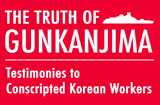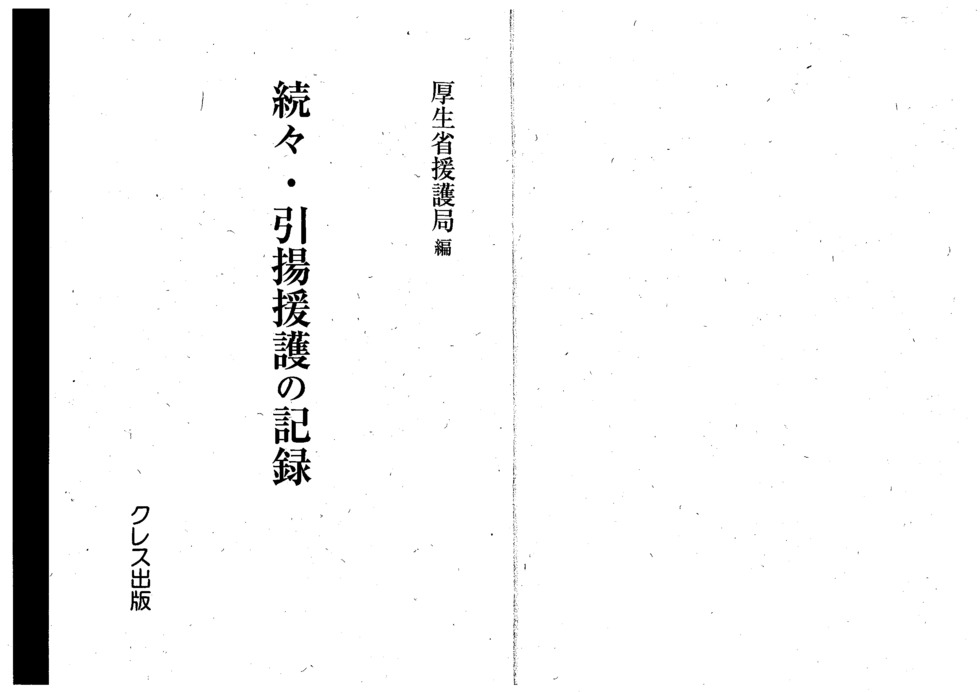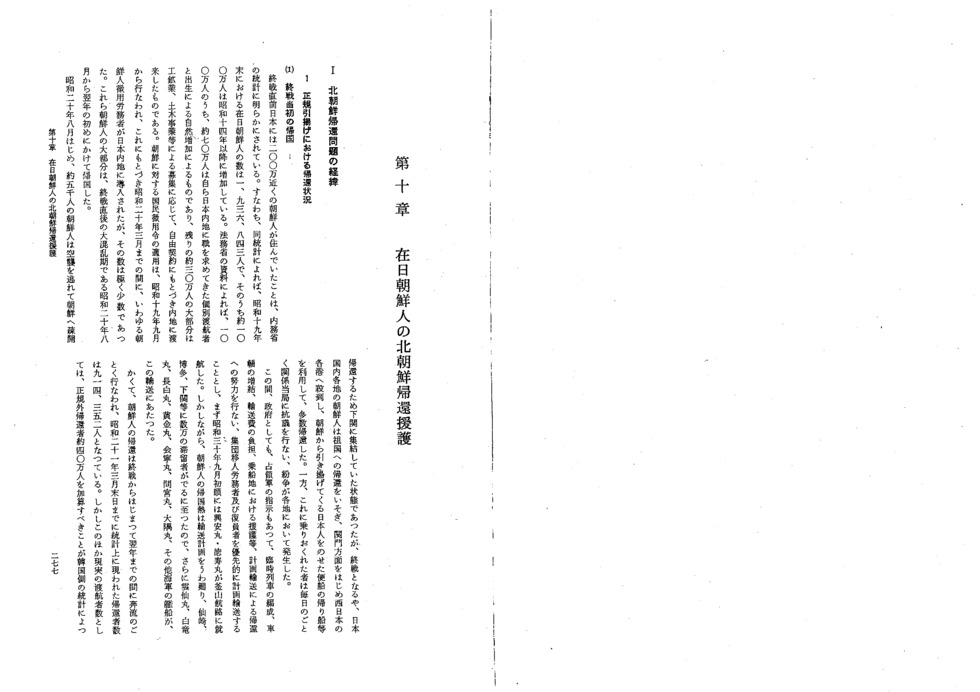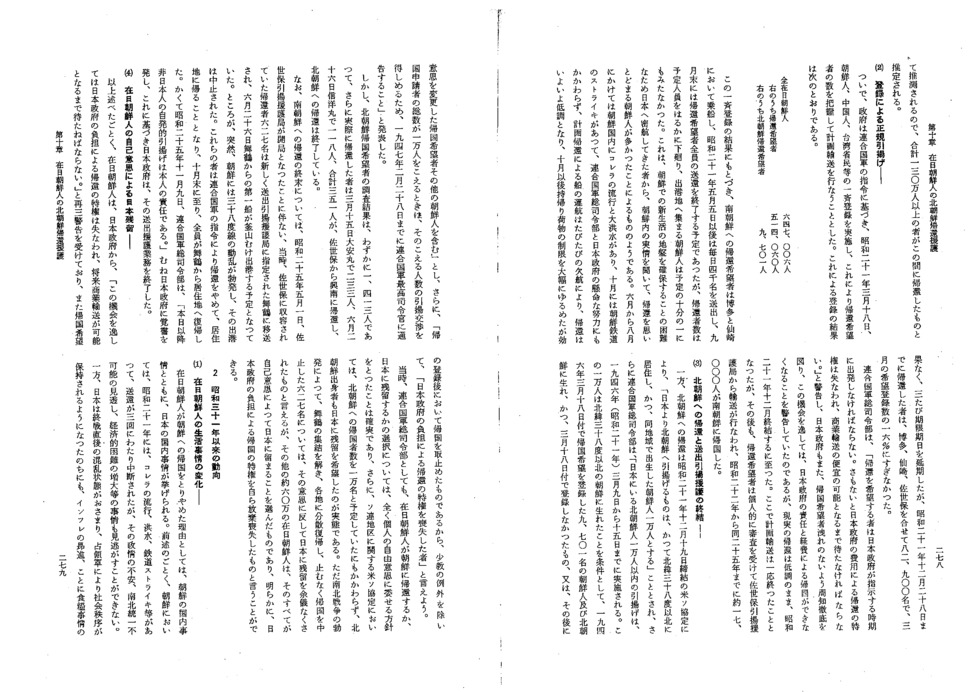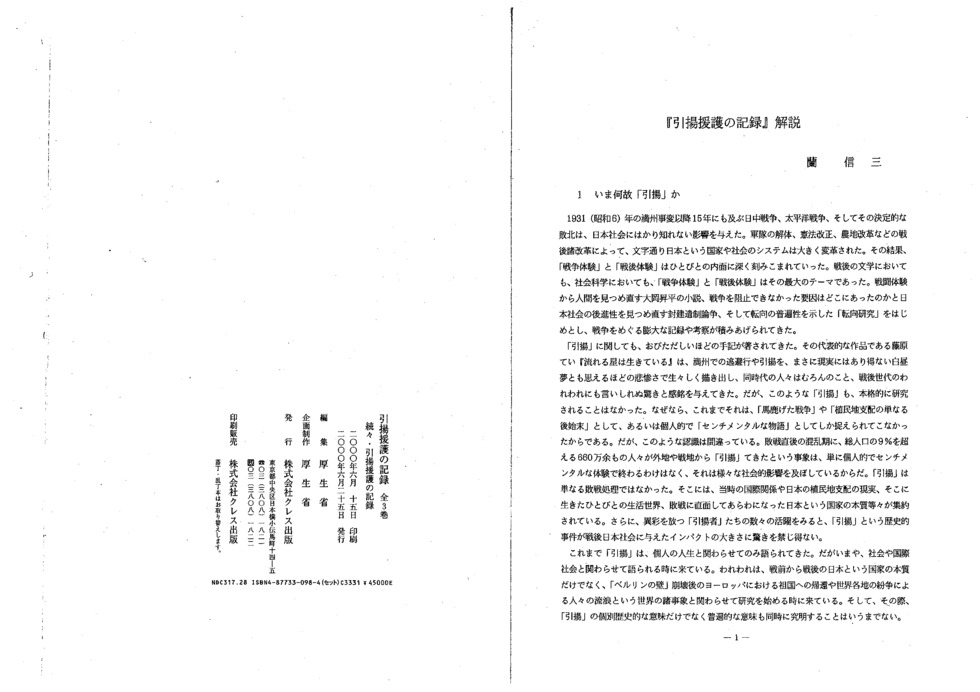Page 1
Page 2
Page 3
Page 4
Chapter 10 Assistance for Repatriation of Korean Residents of Japan to Northern Korea
- Details of the Repatriation to Northern Korea
1 Conditions of Official Repatriation
- Initial repatriation at the end of the war
The fact that nearly two million Koreans were living in Japan just before the war ended is made clear by the statistics of the Home Ministry. According to those statistics, at the end of 1944, there were 1,936,843 Koreans living in Japan, of which about one million constituted increases after 1939. According to Ministry of Justice documents, of those one million, approximately 700,000 were either individual immigrants who had come to Japan on their own seeking work or the natural increase from births, and most of the remaining approximately 300,000 had come to Japan under free contracts in response to recruitments for mining and manufacturing, civil engineering and construction, etc. The National Requisition Ordinance was applied to Korea from September 1944, and based on this, so-called Korean conscripted laborers were introduced to Japan through March 1945, but their numbers were extremely small. Most of these Koreans repatriated during the period of great chaos just after the war ended from August 1945 thorough the beginning of the following year.
At the beginning of August 1945, approximately 5,000 Koreans had gathered in Shimonoseki to evacuate to Korea to escape from air raids, but when the war ended, Koreans living in all parts of Japan immediately rushed to return to Korea, with a huge influx to the ports in the Kanmon Straits area and throughout western Japan, and large numbers of Koreans repatriated on the return voyages of ships carrying Japanese nationals back from Korea. Meanwhile, individuals who failed to board those ships protested to the concerned authorities almost daily, and disputes broke out in each region.
During this period, the government had been ordered by the Occupying Forces and made efforts toward repatriation by planned transport which included forming special trains, adding extra train cars, bearing transport costs, and providing assistance at boarding locations. The government implemented planned transport giving priority to migrant laborers who were in groups and to demobilized persons, and at first the Koanmaru and Tokujumaru began ferry service to Busan in early September 1945. However, the Koreans’ zeal to repatriate surpassed the transportation plan, and tens of thousands gathered waiting in Senzaki, Hakata, Shimonoseki, etc., so the Unzenmaru, Hakuryūmaru, Chohakumaru, Ogonmaru, Kaineimaru, Mamiyamaru, Osumimaru and some Navy vessels were also used for this transport.
In this way, the repatriation of Koreans took place in a torrent from the end of the war through the following year, with the statistics recording the repatriation of 914,352 Koreans through the end of March 1946. However, statistics from the Korea side estimate that approximately 400,000 persons who repatriated informally should be added to the actual number, so it is estimated that a total of more than 1.3 million Koreans repatriated during this period.
- Number of official repatriations by registration
Under orders from the Allied Forces, the government registered all Koreans, Chinese, Formosans, etc. on March 18, 1946, grasped the number of individuals desiring repatriation based on this, and decided to carry out planned transport. The results of the registration were as follows.
Total Number of Korean Residents in Japan 647,006
(Of which) Number desiring repatriation 514,060
(Of which) Number desiring repatriation to northern Korea 9,701
Based on the results of this registration, persons desiring repatriation to southern Korea embarked at Hakata and Senzaki under a plan to send 4,000 each day from May 5, 1946 and to repatriate all those desiring to return to southern Korea by the end of September. However, the number of persons repatriating was far below expectations and the number of Koreans who gathered at the embarkation ports was less than one-tenth of the projections. Apparently, this was because many Koreans abandoned their plans for repatriation when they heard about the actual conditions in Korea from Koreans who had smuggled themselves into Japan because they found it difficult to secure the foundations for a new life in Korea. Korea suffered a cholera epidemic and catastrophic floods between June and August, and Korean railway workers went on strike in October. So, despite the earnest efforts of the GHQ and the Japanese government, the operation of ships under the planned repatriation was frequently cancelled, repatriation eventually turned sluggish. Greatly easing the restrictions on the luggage that could be carried home from October had no effect, and the deadline date was extended three times. Regardless, the number of Koreans who repatriated from Hakata, Senzaki, and Sasebo through December 28, 1946 totaled 82,900, which was merely 16% of those registered in March as wanting to repatriate.
The GHQ warned that those desiring repatriation must depart at the time directed by the Japanese government, and if not, they would lose their right to repatriate at Japanese government expense and would have to wait until passage by commercial vessel became available. The Japanese government also made every effort to inform the Korean residents of Japan so that none desiring repatriation would be left, and warned that if they missed this opportunity, they would lose the chance to repatriate at Japanese government responsibility and expense, but actual repatriation remained dull until it ended in December 1946. With that, planned transport ended for the time being, but even thereafter Koreans desiring to repatriate were returned to Korea after individual inspection by the Sasebo Repatriation Assistance Office, and approximately 17,000 Koreans were repatriated to southern Korea between 1947 and 1950.
- Repatriation to northern Korea and conclusion of repatriation assistance
Meanwhile, regarding repatriation to northern Korea, the agreement between the US and the USSR concluded December 19, 1946 stated that the persons to be repatriated from Japan to northern Korea would be 10,000 Korean nationals who previously lived north of the 38th parallel and those who were born there. Additionally, the GHQ stipulated that the repatriation of up to 10,000 northern Koreans in Japan would be carried out from March 9 through March 15, 1946, and that these 10,000 persons would include 9,701 Koreans required to have been born in Korea north of the 38th parallel who registered their desire to repatriate on March 18, 1946 and other Koreans who were born in northern Korea and had not registered on March 18 but subsequently changed their minds to desire repatriation. The GHQ also announced that if the total number applying for repatriation exceeded 10,000, the Japanese government was to notify the Supreme Commander of the Allied Forces by February 28, 1947 to hold negotiations on the repatriation of that excess number of people.
However, the survey results showed there were only 1,413 persons who wanted to return to northern Korea, and furthermore the actual number of persons who repatriated from Sasebo to Hungnam was 233 on the Taianmaru on March 15, and 118 on the Shinyomaru on June 26 for a total of 351 persons, and that concluded the repatriation to northern Korea.
As for the conclusion of repatriation to southern Korea, with the closure of the Sasebo Repatriation Assistance Office on May 1, 1950, the 627 persons desiring repatriation then held at Sasebo were transferred to Maizuru, where a new repatriation assistance office was established, and the first ship from Maizuru to Busan was to leave on June 26. However, a disturbance suddenly broke out at the 38th parallel, and that voyage was canceled. These individuals were ordered by the Allied Forces to abandon repatriation and return to their residences in Japan, and by the end of October all of them had been returned from Maizuru to their residences. Then on November 9, 1950, the GHQ sent the Japanese government a memo to the effect that “from today, the voluntary repatriation of non-Japanese will be under their own responsibility,” and based on that the Japanese government concluded its outbound repatriation operations.
- Korean residents who chose of their own will to remain in Japan
As stated above, Korean residents of Japan were repeatedly warned by the Japanese government that if they missed this opportunity, they would lose the right to repatriate at Japanese government expense, and would have to wait until passage by commercial vessel became available. Also, because they abandoned their plans to repatriate after the registration for indicating their desire for repatriation, with just a few exceptions, they may be considered as individuals who lost their right to repatriate at Japanese government expense.
At that time, the GHQ also certainly adopted the policy that the decision by Korean residents in Japan to repatriate to Korea or to remain in Japan was entirely up to the individual free choice of each Korean. Also, even though the agreement between the US and USSR regarding areas under Soviet control expected that 10,000 Koreans residing in Japan would return to northern Korea, in fact many who were born in northern Korea desired to remain in Japan. While it may be said that those 627 persons who were dispersed from Maizuru with the outbreak of the war between the north and the south and returned to each region of Japan and had to abandon repatriation were forced to remain in Japan against their will, but the other approximately 600,000 Korean residents of Japan all chose to remain in Japan of their own free will and clearly abandoned their right to repatriation at Japanese government expense.
